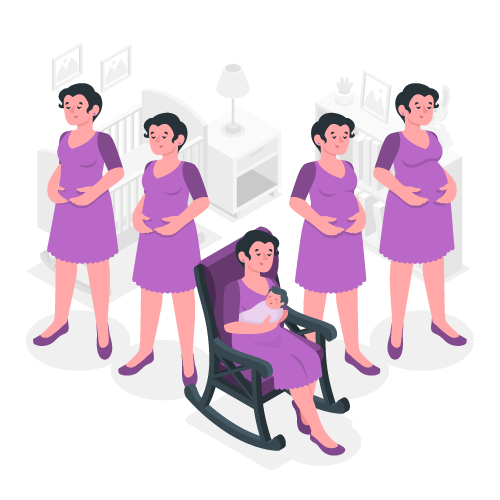
About Low-Risk Pregnancy
A low-risk pregnancy is one where you and your developing baby are generally healthy, and there are no major complications anticipated. This doesn’t mean there won’t be any challenges, but it indicates a smoother pregnancy journey with a lower chance of needing interventions.
Common Discomforts in a Low-Risk Pregnancy
Even in a low-risk pregnancy, some discomforts are common:
- Morning sickness: Nausea and vomiting, usually in the first trimester.
- Fatigue: Feeling tired during the first trimester and again in the third.
- Frequent urination: As the uterus grows, it puts pressure on the bladder.
- Backache: Hormonal changes and weight gain can contribute to back pain.
- Breast tenderness: Changes in preparation for breastfeeding can cause breast soreness.
- Mood swings: Hormonal fluctuations can affect mood and emotions.


Low-Risk vs High-Risk Pregnancy
Low-risk: Healthy mom and baby, typical development, minimal complications expected.
High-risk: Pre-existing conditions (diabetes), pregnancy complications (placenta previa), requiring closer monitoring and potentially specialized care.
Signs of Labor in a Low-Risk Pregnancy
- Regular contractions: Coming at regular intervals and increasing in intensity.
- Bloody show: Loss of mucus plug with some blood, indicating the cervix is dilating.
- Water breaking: Amniotic sac ruptures, releasing fluid.
- Increased pressure or pelvic pain: Baby’s head pushing down on the cervix.
Important Note: Even in a low-risk pregnancy, it’s crucial to attend regular prenatal checkups with your doctor to monitor your health and the baby’s development.
Low-Risk Pregnancy Cost in Delhi (2025)
Costs vary depending on factors like doctor’s experience, hospital type, and birthing options.
- Prenatal care (doctor visits, tests): ₹50,000 – ₹1,00,000
- Delivery (vaginal, low-intervention): ₹50,000 – ₹1,50,000
Remember: This is a general range. Get a personalized cost estimate from your chosen doctor or hospital based on your specific needs and birthing plan.
Additional Tips:
- Prenatal education: Classes can help you prepare for childbirth and parenthood.
- Healthy lifestyle: Eat a balanced diet, exercise regularly, and get adequate sleep.
- Support system: Lean on your partner, family, and friends for emotional support.

FAQs
2. Do I need genetic testing for a low-risk pregnancy?
Genetic testing is optional for a low-risk pregnancy. It can screen for conditions like Down syndrome. Discuss with your healthcare provider based on your family history and personal preferences.
3. Is spotting or light bleeding normal in a low-risk pregnancy?
Spotting or light bleeding can be normal, especially in the first trimester. Always inform your healthcare provider to rule out complications, and seek immediate care if bleeding is heavy.
4. Can I still travel during a low-risk pregnancy?
Travel is generally safe during a low-risk pregnancy, particularly in the second trimester. Consult your healthcare provider before traveling and ensure you stay hydrated, move around, and have access to medical care.
5. Sex during low-risk pregnancy: is it safe?
Sex is typically safe during a low-risk pregnancy unless advised otherwise by your healthcare provider. Discuss any discomfort or concerns with your provider.
6. Do I need ultrasounds for a low-risk pregnancy?
Yes, ultrasounds are standard in a low-risk pregnancy. Typically, one is done at 8-12 weeks to confirm the pregnancy and another at 18-22 weeks to check the baby’s development. Additional ultrasounds may be needed based on your healthcare provider's recommendations.
